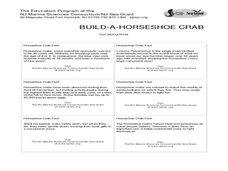McGraw Hill
Arthropods
Are spiders related to crabs? Study the order of arthropods with a reading selection about animal diversity. It provides details about each class within the order, as well as vivid pictures and explanatory charts.
Fairfax Public Schools
Walter Dean Myers
If you are reading works by Walter Dean Myers in your class, this resource might be worth a look. Included here are activities and discussion questions for Malcolm X: By Any Means Necessary, Somewhere in the Darkness, Scorpions, Fallen...
Curated OER
It's not just pretty - it's a survival method!
First graders write explanations for why certain animals can only live in certain environments. In this animal survival lesson plan, 1st graders take pictures of animals and place them into the right environment after a lesson on the...
Curated OER
Who Lives with Mallard?
Students color a picture of the habitat featuring mallard and other creatures, some of whom might be camouflaged or half-hidden. They discuss other forms of animal adaptation.
Curated OER
Holes: Setting and Inferences
Learners read the book Holes, and draw a picture of the setting and answer questions about inferences regarding the book. They answer two questions and draw one setting.
Curated OER
Sonoran Desert
In this Sonoran Desert worksheet, learners read and analyze a letter that Jeremy wrote to his grandmother and then complete the picture that follows using information about the desert they learned from the letter.
Curated OER
Counting Exercise
In this early childhood counting activity activity, students examine a picture and count and record the number of squares, spiders, beetles, and scorpions.
Curated OER
Letter S Connect The Dots; 1-20 Worksheet
In this language arts and counting worksheet, student complete a dot to dot puzzle using the numbers 1-20 to make a seal. They write 6 other animal names that begin with the letter s on the lines below the picture.
Curated OER
Desert Similes
In this desert similes fill-in-the blank worksheet, students read the definition of a simile at the top of the page. They write 10 similes using desert words that are shown in a box at the top of the page. They draw a picture of one of...
Curated OER
Which One is an Insect?
In this science worksheet, students categorize 18 words as either insects or not insects. Students write the words in a two-column chart under the correct category.
Curated OER
Fly Detective
Learners use classification skills and clues to determine which flying insect is the one they need to circle. They read four clues and examine each of the five insects depicted. They then deduce which one is the mystery insect. Answers...
New South Wales Department of Education
Invertebrates
Of all invertebrates, insects by far are the most numerous. Scholars discuss invertebrates and then use a key to classify them. They see different examples and must describe features of each organism based upon the key.
American Museum of Natural History
What's This? Colorful Creatures
An online resource shows learners some species that are very good at using their camouflage as well as other ways species use their coloring for survival. Interactive and digital, the lesson is perfect as a remote learning resource.
Curated OER
Invent an Insect
Explore biology by researching adaptation. First, learners research and define a list of insect vocabulary terms and discuss the benefits of each insect characteristic. They then utilize a worksheet to create their own insect and share...
Curated OER
Scientists Find 27 New Species in Caves
Students share their knowledge of creatures that live in caves, then read a news article about new cave animals that have been found in California. In this current events lesson, the teacher introduces the article with a discussion and...
Curated OER
Create An Insect
Students create a new species of insect. They create a list of insect characteristics and use this as a springboard to draw an insect of their own. Students write a brief descriptive paragraphs about their insect, giving particular...
Curated OER
Power Point Lesson Plan
Students create a multimedia animal research presentation based on the include criteria for both information and sideshow format. They follow directions on slide set-up from creating a slide to transitions and musical insertion.
Curated OER
Introduction to Spiders
Learners discover various facts about spiders including different species, body parts, and types of webs. In this insect biology lesson, students begin a K-W-L chart about spiders, are read I Love Spiders by John Parker and Amazing...
Curated OER
Habitats of the World
Students complete a unit of eighteen lessons that cover climate, geography, location, plants, and animals of each of the five habitats. They are also introduced to habitat destruction and discuss ways to protect the environment. They do...
Curated OER
Wacky Water Critters
Students visit a local creek or stream. They collect water samples from the creek and observe and sort the "water critters" they find in the sample, observing smaller organisms under a microscope if necessary. They identify each organism...
Curated OER
Build-A-Horseshoe Crab
Students discover many facts about horseshoe crabs. Students identify the main body parts of horseshoe crab. They explore the habits of the horseshoe crab and their importances to the ecosystem. Adaptations for younger students are...






















